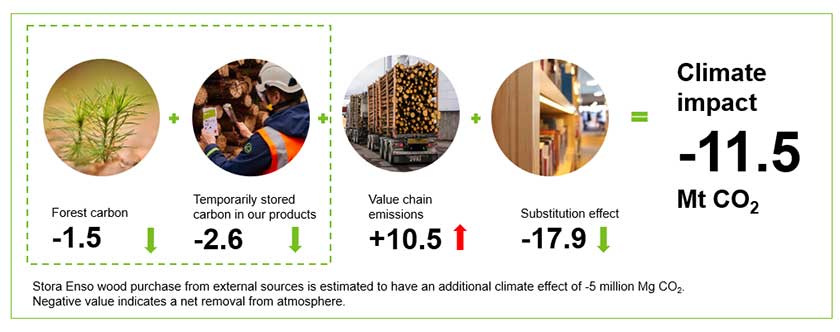Forests and products made from wood can play a significant role in the fight against climate change. The data and claims about our positive climate impact are based on solid science; Stora Enso is collaborating with the Swedish University of Agricultural Sciences (SLU) to develop more accurate climate impact research for forest product companies. A new report, providing evidence of Stora Enso’s positive climate impact was published in November 2020. We spoke with researcher Torun Hammar, PhD, who was part of the research team.
“The research was done at a company level, where a system perspective considering all aspects of forestry was applied, connecting the production of renewable raw material from wood with forest carbon fluxes and value chain emissions. It also takes into account how Stora Enso’s products can substitute other greenhouse gas intensive materials and energy - for example plastics or concrete,” says Hammar.
Stora Enso has been calculating and reporting its value chain emissions according to the Greenhouse Gas Protocol for years. One of the key items in the new study was to deepen the understanding of how carbon is stored in forest and wood-based products. “Instead of only focusing on the value chain emissions, we have looked more carefully at the biogenic carbon fluxes, which means changes in the amount of carbon in forests and tree plantations over time owned or leased by Stora Enso, and the carbon that is temporarily stored in the wood-based products the company produces,” Hammar explains.
Sustainable forestry at the core
It is crucial that the wood comes from sustainably managed forests. Sustainable forestry ensures that the forests are regenerated, and that new trees are planted to replace those harvested. Growing trees remove carbon dioxide from the atmosphere, and the carbon cycle continues.
When trees are harvested, the carbon stored in the wood fibers is not released immediately but continues to be stored in products made from that wood. How long the carbon remains stored in the fibers depends on how long the product stays in use. With wooden buildings, for example, the timespan is decades, even centuries. “In Stora Enso’s case, the biggest climate benefit comes from solid wood products, where the biogenic carbon is stored for longer and where the substitution effect is big,” Hammar says. “Substitution effect” refers to emissions that can be avoided, because a renewable material originating from a sustainably managed source was chosen instead of a fossil-based one.
Significant climate benefits
“We carefully evaluated all product substitution assumptions with the research team and Stora Enso,” says Hammar. “The products Stora Enso produces need to be suitable for replacing a product made from another material. For example, liquid carton board can substitute PET plastic (polyethylene terephthalate), the EcoFishBox can be used as a substitute for EPS (expanded polystyrene) boxes, and wooden building materials replace concrete or steel.”
When Stora Enso’s renewable products are chosen to replace fossil-based or other non-renewable alternatives, they have significant benefits for society. When this happens, it is possible to prevent almost 18 Mt of CO2e from entering the atmosphere annually. Eventually, when the products have reached the end of their lifecycle, they can also be used as renewable and carbon neutral energy that can replace fossil-based energy.
Science-based calculations build trust in the data
“Climate impact calculations need to be based on science and the most up-to-date available knowledge. The analysis is quite complex, and this project adds to previous research by including more products in the substitution calculations,” says Hammar. “Companies are also constantly innovating, and new products are being introduced to the markets. These new products should be considered in the climate impact calculations. Hopefully, there will be a commonly agreed method that will make it easier to compare the performance and impact of different companies. There is always more research to be done,” she concludes.
Stora Enso is estimated to have a positive impact on the climate equivalent to a reduction of 11,5 million tonnes of CO2e from the atmosphere (2019 data). This equates to the CO2 emissions of some 5 million midsize cars driving 20 000 km annually. The SLU research presents an advanced calculation model of the company’s climate impacts. One of Stora Enso’s goals with research collaboration between industry and universities is to build trust in the data and improve transparency.



